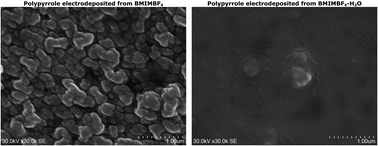Surface morphology and corresponding electrochemistry of polypyrrole films electrodeposited using a water miscible ionic liquid
Abstract
Polypyrrole layers were deposited on polycrystalline gold from solutions of pyrrole in the ionic liquid 1-butyl-3-methylimidazolium tetrafluoroborate and its equimolar mixture with water by using potential controlled electrochemical methods. Cyclic voltammetry, electrochemical impedance spectroscopy, scanning electron microscopy and dispersive X-ray microanalysis were characterization methods of polymeric products. The morphology of the solution side of the polymer layers depended on the composition of the polymerization bath and layer thickness. Correlations between impedance parameters and surface morphologies were investigated. Intermolecular interactions in the ionic liquid and in its mixture with water were invoked to discus packing motifs of the polypyrrole chains deposited on gold. Different morphologies of the polypyrrole films, from a crystal-like solid to a colloid semi-rigid liquid, were observed for the submicrometer films. Values of the double layer impedance frequency dispersion parameter as well as elemental microanalysis data are consistent with the surface morphology images. The charge transport processes of the polypyrrole electrode are impacted by the morphology as well as thickness of the thin polymer films. The ionic liquid electrolytes can be used to tailor the micro and nanostructures of electrodeposited polypyrrole.

- This article is part of the themed collection: Nanoscience and nanotechnology in electrochemistry

 Please wait while we load your content...
Please wait while we load your content...